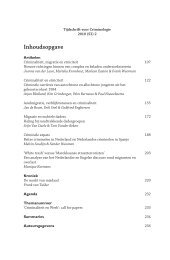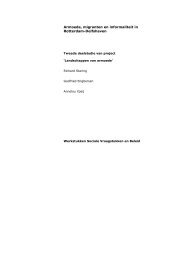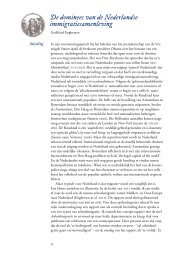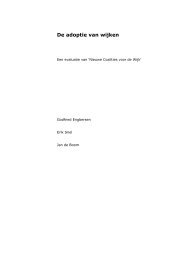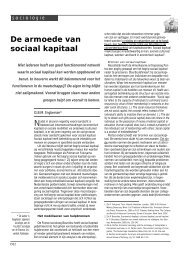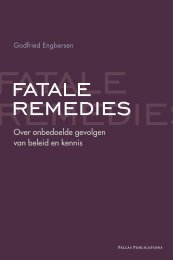THE SOCIAL CONSTRUCTION OF ILLEGALITY AND CRIMINALITY ...
THE SOCIAL CONSTRUCTION OF ILLEGALITY AND CRIMINALITY ...
THE SOCIAL CONSTRUCTION OF ILLEGALITY AND CRIMINALITY ...
Create successful ePaper yourself
Turn your PDF publications into a flip-book with our unique Google optimized e-Paper software.
6<br />
GODFRIED ENGBERSEN <strong>AND</strong> JOANNE VAN DER LEUN<br />
ILLEGAL IMMIGRANTS’ DIFFERENTIAL INVOLVEMENT IN CRIME<br />
So far, there is very little systematic empirical support for the equation of<br />
illegal immigrants with crime. Within the framework of the Unknown City<br />
project, a first indication can be found in the interviews with 170 illegal<br />
immigrant in Rotterdam. Apart from the use of false or forged documents,<br />
which the respondents considered unavoidable, the majority of the interviewed<br />
illegal immigrants refrain from criminal activities. They do everything<br />
they can to keep on the right side of the law and commonly find<br />
other ways of making a living. A small part of the respondents is involved<br />
in prostitution (which can be labelled as a ‘semi-criminal’ activity) and in<br />
street-level drug trading. The latter is mainly the case with Moroccan and<br />
Algerian migrants, who work as ‘runners’ for dealers who cater for tourists<br />
in Rotterdam. They find themselves in subordinate and relatively<br />
marginal positions and their criminal activities are mainly oriented towards<br />
survival (Engbersen and Van der Leun 1998).<br />
In order to find more substantial empirical evidence, the interviews were<br />
supplemented with an analysis of three samples drawn from the files of<br />
the Rotterdam police. The main sample consisted of 330 apprehensions of<br />
illegal immigrants and was taken from the files of the Aliens Police. Two<br />
control samples were used, made up of 590 apprehensions of legal immigrants<br />
and 640 crime suspects legally residing in Rotterdam. In addition,<br />
we analysed all apprehensions of illegal immigrants in 1995 in Amsterdam,<br />
Rotterdam, The Hague and Utrecht together, which were almost 7,000<br />
files pertaining to more than 6,000 illegal immigrants. The illegal immigrants<br />
who are registered are apprehended by the Aliens Police or handed<br />
over by basic police units because of illegal labour and/or illegal residence.<br />
Furthermore, a small part was handed over by the Railway Police, the<br />
Military Police or by detention centres. It must be noted that the likelihood<br />
of being apprehended is highly dependent on the behaviour of the<br />
illegal immigrants. People who live their lives ‘in the shadows’ have a low<br />
probability of being asked to show their documents, whereas those who<br />
work together with other illegal immigrants and those who engage in criminal<br />
activities, or in other ways attract attention, run a higher risk. Although<br />
police data are inevitably selective, these were the only data that could help<br />
us to gain some insight in patterns of apprehension. 5 Table I provides an<br />
5 Police data have to be handled with care. Nonetheless, in many instances, they are<br />
still the most suitable data to gain insight into patterns of criminal activities (cf. Hagan<br />
and Peterson 1995; Tonry 1997). Rather than deny the validity of these data per se, the<br />
procedure followed here is to study the statistics as a useful source of information, in<br />
particular when combined with the enthnographic research.



